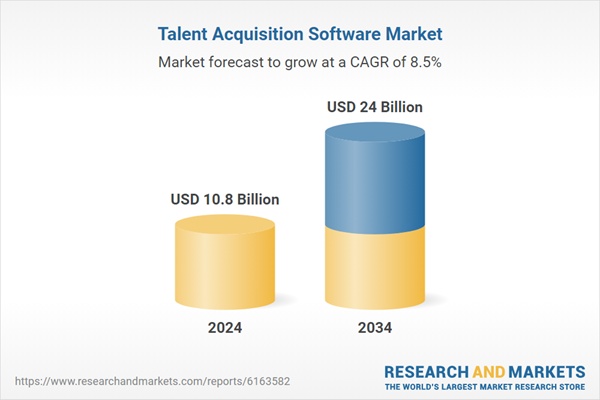In response to workforce disruptions since 2020, enterprises have accelerated investments in virtual hiring tools. These include online interviews, remote onboarding systems, and AI-powered sourcing platforms. Recruitment responsibilities are now expanding beyond HR, with departments like engineering and sales leveraging CRM-style recruiting interfaces to improve candidate outreach. Advanced software capabilities allow internal teams to deploy resources more efficiently, particularly in remote settings. AI-driven features now automate resume parsing, candidate ranking, and intelligent job distribution. Vendors such as iCIMS and Cornerstone have already implemented algorithms that analyze historical hiring trends to score talent, improving the speed and quality of recruitment outcomes.
The cloud-based platforms segment held 79% share in 2024, with a projected CAGR of 9.4% through 2034. This leadership stems from the rising need for agile, scalable, and remote-compatible systems. Platforms like Greenhouse, SAP SuccessFactors, Oracle Recruiting Cloud, and Workday are favored for their fast deployment, ease of integration, and low upfront costs. Their compatibility with productivity tools, job boards, and enterprise APIs supports a seamless hiring ecosystem that accommodates increasingly diverse and distributed workforces.
The services segment held a significant share in 2024. The user training, consultation, implementation, and integration - deliver both platform providers and third-party system integrators a growing strategic role. While this segment currently contributes less to overall revenue, its importance is rising as companies demand customization, system alignment with existing HR tech stacks, and guidance on emerging ethical and compliance concerns around AI. Enterprises are also seeking help in managing change as they overhaul legacy recruitment processes.
U.S. Talent Acquisition Software Market held an 85% share, generating USD 4.1 billion in 2024. This dominance is driven by the broad adoption of advanced recruiting systems among large corporations managing complex hiring workflows. The growing integration of AI into recruitment - from predictive analytics to intelligent sourcing - has transformed traditional hiring processes. Companies across sectors are embracing cloud-native HR models, investing in digital upgrades, and prioritizing compliance and scalability in their hiring tech stacks.
The top seven players shaping the competitive landscape in the Global Talent Acquisition Software Market include Recruit Holdings, Workday, SAP SE, Oracle, iCIMS, ADP, and Cornerstone. To secure stronger market positions, leading companies in the talent acquisition software space are investing heavily in AI innovation, automation, and cloud-first delivery models. They are expanding platform capabilities to cover the full talent lifecycle - from sourcing and engagement to onboarding and retention. Vendors are also embedding machine learning into core functions like candidate scoring and pipeline forecasting. Strategic partnerships with HR tech ecosystems, API integration with third-party platforms, and support for mobile and remote-friendly features are top priorities. These firms are offering flexible deployment models, data-driven decision tools, and enhanced compliance functionalities.
This product will be delivered within 2-4 business days.
Table of Contents
Companies Mentioned
The companies profiled in this Talent Acquisition Software market report include:- IBM
- Microsoft
- Oracle
- SAP
- Workday
- BambooHR
- Bullhorn
- Cornerstone on Demand
- Greenhouse Software
- iCIMS
- JazzHR
- Jobvite
- Lever
- SmartRecruiters
- Zoho
- Beamery
- Eightfold AI
- Paradox
- Pymetrics
- SeekOut
- Textio
- HireHive
- iSmartRecruit
- Manatal
- Recruitee
Table Information
| Report Attribute | Details |
|---|---|
| No. of Pages | 170 |
| Published | July 2025 |
| Forecast Period | 2024 - 2034 |
| Estimated Market Value ( USD | $ 10.8 Billion |
| Forecasted Market Value ( USD | $ 24 Billion |
| Compound Annual Growth Rate | 8.5% |
| Regions Covered | Global |
| No. of Companies Mentioned | 26 |









